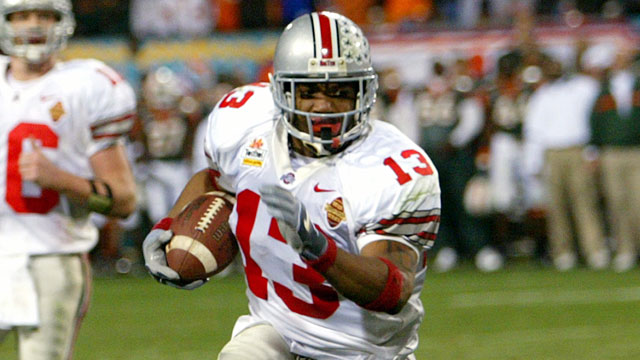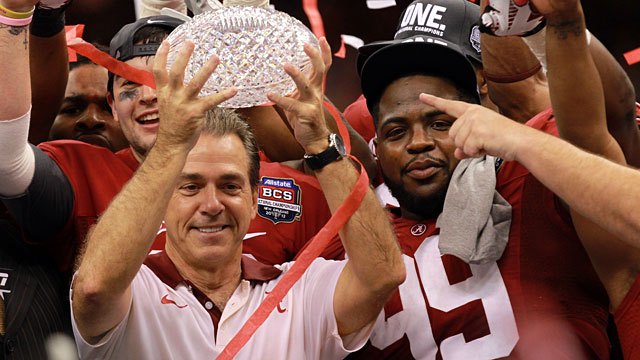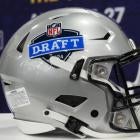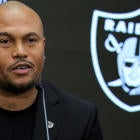
The Supreme Court ruling on June 27, 1984, that ended the NCAA's monopoly of college football on television opened the door for the sport to become a multi-billion-dollar industry. Since the landmark Supreme Court decision, these moments helped college football explode, too.
BYU wins national title (1984)
In the wake of the Supreme Court ruling, BYU played at Pittsburgh in the first live national college football broadcast on ESPN. BYU pulled off the road upset, shot up the polls and got on the national radar. BYU finished the regular season undefeated and No. 1 in the polls. But No. 2 Washington opted for a bigger bowl payout against Oklahoma, leaving BYU to beat six-win Michigan at the Holiday Bowl. BYU was awarded the consensus mythical national champion. Since 1984, no school outside of a current major conference (other than Notre Dame) has won a national title.
Penn State upsets Miami (1987)
The underdog Nittany Lions' 14-10 victory at the 1987 Fiesta Bowl for the national title stunned the country. NBC shifted the Fiesta to primetime for the matchup, which drew a 25.1 rating that's the highest on record ever for a college football game.
Penn State was outgained 445 yards to 162 and its quarterback completed just 5 of 16 passes. But the Nittany Lions intercepted Heisman Trophy winner Vinny Testaverde five times.
SMU death penalty (1987)
From 1981 to 1984, a small private school in Dallas produced the best record in college football. But SMU soon became unhinged as boosters, including then Gov. William Clements and others on the school's Board of Governors, were involved in blatant NCAA violations. The NCAA handed out the first “death penalty” -- no SMU football for a year. The school didn't play the next year, either. The shutdown set SMU back two decades and the NCAA has never again imposed the death penalty, instead fluctuating in how it penalizes cheaters.
Notre Dame leaves CFA for NBC (1990)
Just two weeks after the College Football Association reached a $210 million deal with ABC for its 63 schools, Notre Dame bolted from the CFA to go solo with NBC for $38 million over five years. The landmark deal caused ABC to scale back its contract with the CFA by about $25 million and gave new meaning to Notre Dame's independent status. Notre Dame was criticized for pursuing its own agenda to the detriment of other members of the CFA, which Fighting Irish administrators helped create. Most schools couldn't pull off a deal like this, but it offered a blueprint for conferences.
Conference realignment (1990s)
In the early 1990s, the era of independents came to an end as the CFA neared its demise to negotiate TV money for a group of about 60 schools. Penn State joined the Big Ten after the Big East fatefully passed on the Nittany Lions. Miami went to the Big East. Florida State went to the ACC. Arkansas joined the SEC, signaling the end of the Southwest Conference.
First SEC Championship Game (1992)
Alabama entered the 1992 SEC Championship Game with an 11-0 record and a No. 2 national ranking and faced Florida, which had a disappointing 8-3 season. At the time, opinions were sharply divided on whether conference championship games would be good for conferences. SEC commissioner Roy Kramer rolled the dice.
Alabama won 28-21 on a late interception for a touchdown by Antonio Langham and later captured the national title. Conference championship games were here to stay and would impact the value and exposure of conferences.
SEC cashes in with CBS (1994)
In the first defection from the CFA package since Notre Dame, the SEC agreed to a five-year contract with CBS for $100 million. This put the SEC in a national Saturday afternoon platform instead of ABC's mainly regional broadcasts. Other conferences would later break off from the CFA and create their own television packages.
Creation of the BCS (1998)
The precursor to the playoff, the Bowl Championship Series matched No. 1 vs. No. 2 every year for the national title. As controversial as it could be, the BCS was also incredibly lucrative (payouts started at $90 million per year and more than doubled over its 16-year life). The BCS added value to regular season games. College football became a more national sport as fans tuned into games all over the country given the BCS stakes.

BCS controversies (Pick a year)
LSU and USC split a national title in 2003 -- the very thing the BCS was supposed to avoid. Undefeated Auburn got left out of the BCS Championship Game in 2004, causing SEC commissioner Mike Slive to propose a playoff model (without actually using the “p” word). When the BCS fielded an All-SEC championship game between Alabama and LSU in 2011 as a rematch, more conferences opened up to the idea of a playoff and the new money attached to it.
Conference realignment (mid-2000s)
The ACC started the next wave of expansion in 2003 by adding Miami and Virginia Tech. Boston College later joined the ACC as well. Long known as a basketball conference, the ACC understood the future of college sports hinged on television money. Essentially, either the ACC or Big East would get swallowed by the other. The ACC did the eating to stay alive.
Maurice Clarett sues to join NFL early (2003)
Ohio State star Maurice Clarett sued the NFL, challenging the NFL rule that bars players from turning pro until they're three years removed from high school. Clarett lost his case, which reached the Supreme Court. Clarett led the Buckeyes to a national title as a freshman in 2002, but he was ruled ineligible as a sophomore for accepting money and lying about it to NCAA and university investigators. More than a decade later, the NFL and NBA rules still result in NCAA schools signing some elite players who don't want to be in college and have no other options.
Non-BCS schools push back (2003)
Tulane president Scott Cowen organized a group of more than 40 university presidents who aren't a part of the BCS to gain more access to college football's lucrative major bowls. At that point, a team from a non-BCS conference had never participated in the four most lucrative bowl games. The BCS created a fifth bowl game through double-hosting by the national championship site, giving America upsets such as Boise State over Oklahoma and Utah over Alabama.
Texas vs. USC at Rose Bowl (2006)
Arguably one of the greatest college football games ever ended with a Vince Young touchdown to deny USC's attempt at a three-peat. The BCS championship at the Rose Bowl drew a 21.7 TV rating, making it the highest-rated BCS game ever and the highest-rated college football game since the 1987 Fiesta Bowl between Miami and Penn State.
The Rose Bowl rated higher than any World Series game since Game 7 in 2001. The Texas-USC viewership helped increase the payouts to conferences during the next round of BCS TV negotiations.
Big Ten creates TV network (2006)
The Big Ten Network announcement started the natural progression of television in college sports: Conferences creating their own TV networks. Big Ten commissioner Jim Delany had been outraged by what he considered a lowball offer from ESPN, so the Big Ten cut out the middleman for some games. The Big Ten fought major distribution challenges initially in 2007 with its $2.8 billion deal over 20 years with Fox, which owns 51 percent. The network now produces about $100 to $110 million per year in revenue and was partially why the conference expanded East to add Maryland and Rutgers for 2014. The SEC, Pac-12 and Texas also now have networks.
Nick Saban: $4 million a year coach (2007)
Saban's hiring at Alabama didn't just transform what happened on the field as the Crimson Tide won three national titles in four years. It also created the first $4-million-a-year coach, raising concerns as Congress again looked into the NCAA's nonprofit status. By 2013, eight coaches made $4 million and Saban's pay is now $6.9 million. Alabama generated $143.3 million in athletic revenue in 2012-13, up 112 percent since Saban arrived.
Tim Tebow wins Heisman (2007)
As college football's popularity and demands have grown, players became more ready to star at a young age. Tebow became the first player to win the Heisman as a sophomore.
Then, Sam Bradford and Mark Ingram won as sophomores the next two years. In the past two seasons, Johnny Manziel and Jameis Winston captured the honor as freshmen.
Ed O'Bannon sues NCAA (2009)
What started as a lawsuit over video games became much bigger. The former UCLA basketball star's suit against the NCAA turned into a class-action suit by football and basketball players over commercial use of their names, images and likenesses. The players unsuccessfully sought to collect damages from appearing on TV broadcasts and are currently at trial attempting to get a share of TV money moving forward.
Conference realignment (2010s)
The Big 12 nearly crumbled as Nebraska joined the Big Ten, Colorado went to the Pac-12, and Texas A&M and Missouri left for the SEC. The ACC added Syracuse, Pittsburgh and Louisville, and secured a football scheduling arrangement with Notre Dame. The Big Ten surprised people by taking Maryland and Rutgers. New Pac-12 commissioner Larry Scott nearly pulled off a 16-team super conference by attempting to get Texas. The potential deal ended when Texas asked for more money at the last minute.
Unprecedented Penn State penalties (2012)
In the wake of the Jerry Sandusky child molestation scandal, the NCAA hit Penn State with unprecedented sanctions: a $60 million penalty, a four-year postseason ban, scholarship reductions, and the vacation of all wins dating to 1998. The NCAA used an outside investigation for its findings instead of its usual enforcement process.
College Football Playoff arrives (2012)
College football gave its fans what they have been clamoring for years: a playoff. Starting in 2014, two seminal games will rotate among six bowl sites on New Year's Eve or New Year's Day and be followed a week or so later with the national championship. The 10 FBS conferences will receive an average of $470 million a year from ESPN for the new postseason system. The Power Five conferences will split about 72 percent of the money.




















